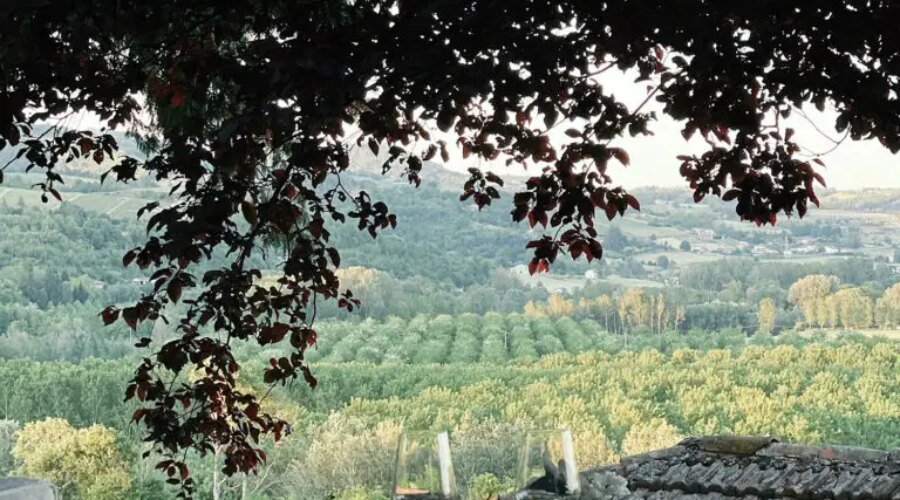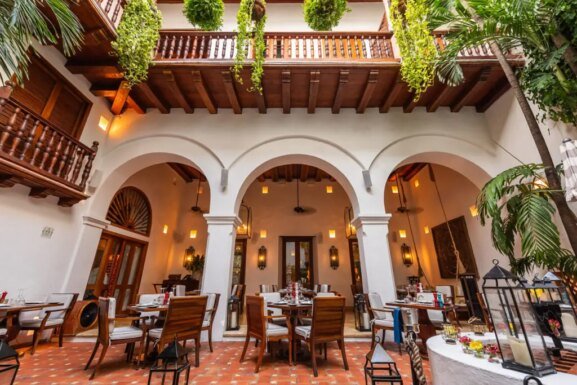The Rise of the Winery Hotel Has Come at the Exact Right Time
I have a complicated relationship with wine country. First, I should clarify that I love it: wandering vine-striped hills, learning from empassioned-if-sleep-deprived winemakers, popping the occasional grape in my mouth when no one is looking, tasting wines in the exact places they were made. It does, however, make me tired. Whether exploring California’s sprawling Central Coast or the storied villages of the Loire Valley, by rental car or exorbitantly priced driver, I used to pack my wine trips with days of tastings and tours from morning to night, until what was left of me was a dehydrated husk of a person.
As I’ve grown older, fought illness, and adapted to a new, more fatigued normal, I can no longer so easily spend a day flitting from winery to winery without so much as a glass of water (or serving of vegetables.) Nor am I so thrilled about the idea of paying for a driver or, worse, navigating a strange little rental car through winding foreign roads.
Like so many others, I’m drinking less wine than I used to, but that doesn’t mean I’m less interested in luxuriating in wine country. Enter: Winery hotels.
Globally, wine tourism is expected to grow 13% by 2034. While hotels that make their own wine are nothing new, the wine tourism boom has fueled the growing category of accommodations that let guests play winemaker and student all at once, in some of the world’s most prestigious wine regions. According to research from Future Market Research, the desire for personalized and immersive wine experiences are fueling wine tourism’s expansion.
It’s the reason why, in August, I traveled to the heart of Piemonte to Villa La Madonna, a boutique hotel surrounded by its own rolling Barbera vines, to enjoy regionally-focused tastings and classes from the comfort of one place.
// Create the element
var script_68e01baacf044 = document.createElement(“script”);
script_68e01baacf044.innerHTML = `
window.googletag = window.googletag || {cmd: []};
googletag.cmd.push(function() {
var adType = “leaderboard”;
var mapping;
var lbmapping = googletag.sizeMapping()
.addSize([1024, 0], [[970, 250], [970, 90], [1, 1], [728, 90]])
.addSize([728, 0], [[728, 90], [1, 1]])
.addSize([320, 0], [[1, 1], [300, 50], [300, 100], [320, 50], [320, 100]])
.addSize([0, 0], [[1, 1], [320, 50]])
.build();; // Size mapping for leaderboard ads
var medrecmapping = googletag.sizeMapping()
.addSize([1024, 0], [[300, 600],[300, 250]])
.addSize([728, 0], [300, 250])
.addSize([320, 0], [[1, 1],[300, 250]])
.addSize([0, 0], [[1, 1], [300, 250]])
.build(); // Size mapping for med rectengle ads
if(‘/39808611/article_page/article_leaderboard_1’ == ‘/39808611/article_page/article_leaderboard_1’
|| ‘/39808611/article_page/article_leaderboard_1’ == ‘/39808611/article_page/article_leaderboard_2’
|| ‘/39808611/article_page/article_leaderboard_1’ == ‘/39808611/article_page/article_leaderboard_3’) {
mapping = googletag.sizeMapping()
.addSize([1920, 0], [[728, 90]]) // >= 1920px
.addSize([1440, 0], [[728, 90]]) // 1440px-1919px
.addSize([730, 0], [[300, 250]]) // 730px-1439px
.addSize([0, 0], [[320, 100], [320, 50], [300, 100], [300, 50], [300, 250]]) // Up to 729px
.build();
} else {
mapping = adType == ‘leaderboard’ ? lbmapping : medrecmapping;
}
googletag.defineSlot(‘/39808611/article_page/article_leaderboard_1’, [],
‘div-gpt-ad-68e01baacf044’).addService(googletag.pubads()).defineSizeMapping(mapping);
googletag.pubads().enableSingleRequest();
googletag.pubads().collapseEmptyDivs();
googletag.display(‘div-gpt-ad-68e01baacf044’);
});
`;
// Append the script to the body
document.body.appendChild(script_68e01baacf044);
Opened in 2016, the hotel not only makes its own red and white wine—available to order at the excellent terrace bar and romantic Piemontese restaurant—but it houses a 1600s-era cellar that holds over 600 labels and 5,000 bottles. Selections include plenty of Barolo and Barbaresco royalty like Gaja, Giacosa, and Conterno, along with picks from emerging, lesser-known houses selected by wine director and guest relations manager Josh Eisenhauer, a Del Posto alum and longtime Italy transplant.

“I focus on storytelling as opposed to a more technical approach to wine tasting,” he says. “We light candles and set the scene hoping to introduce guests to Piemontese culture and history, rather than just telling participants what they should be tasting.”
You can still get technical, if you’d like. In September, after an introduction to the growing season and harvesting process, guests can then actually help harvest Barbera grapes and celebrate with a picnic lunch in the middle of the vineyard. During my summer visit, I settled for a caprese and glass of Villa La Madonna’s crisp, floral Monferrato Bianco, made with Piemonte’s undersung white grape, Arneis, reclining by the pool just an arms-length away from the nearest Barbera vine.
After a long nap in my room, I only had to head downstairs for a tasting in the dark, moody, historic cellar, where Eisenhauer presented wines from some of his favorite nearby producers alongside crispy grissini made just down the road. “The area has become closely associated with red wine, but Piemonte is so much more,” says Eisenhauer, as he poured a Blanc de Blanc Alta Langa DOCG, made in the tradition of the oldest classic method wine produced in Italy.

That night, alongside a dinner of housemade tagliolini with black truffles, I sipped a 2020 Barolo that the property makes in collaboration with Matteo Molino. My day had been packed with special wine experiences: all of which were only accessible to me because they were on-site.
Increasingly, the most luxurious wine country hotels are making their own wines, which offers not just the picturesque backdrop but also the opportunity for guests to geek out.
// Create the element
var script_68e01baacf908 = document.createElement(“script”);
script_68e01baacf908.innerHTML = `
window.googletag = window.googletag || {cmd: []};
googletag.cmd.push(function() {
var adType = “leaderboard”;
var mapping;
var lbmapping = googletag.sizeMapping()
.addSize([1024, 0], [[970, 250], [970, 90], [1, 1], [728, 90]])
.addSize([728, 0], [[728, 90], [1, 1]])
.addSize([320, 0], [[1, 1], [300, 50], [300, 100], [320, 50], [320, 100]])
.addSize([0, 0], [[1, 1], [320, 50]])
.build();; // Size mapping for leaderboard ads
var medrecmapping = googletag.sizeMapping()
.addSize([1024, 0], [[300, 600],[300, 250]])
.addSize([728, 0], [300, 250])
.addSize([320, 0], [[1, 1],[300, 250]])
.addSize([0, 0], [[1, 1], [300, 250]])
.build(); // Size mapping for med rectengle ads
if(‘/39808611/article_page/article_leaderboard_2’ == ‘/39808611/article_page/article_leaderboard_1’
|| ‘/39808611/article_page/article_leaderboard_2’ == ‘/39808611/article_page/article_leaderboard_2’
|| ‘/39808611/article_page/article_leaderboard_2’ == ‘/39808611/article_page/article_leaderboard_3’) {
mapping = googletag.sizeMapping()
.addSize([1920, 0], [[728, 90]]) // >= 1920px
.addSize([1440, 0], [[728, 90]]) // 1440px-1919px
.addSize([730, 0], [[300, 250]]) // 730px-1439px
.addSize([0, 0], [[320, 100], [320, 50], [300, 100], [300, 50], [300, 250]]) // Up to 729px
.build();
} else {
mapping = adType == ‘leaderboard’ ? lbmapping : medrecmapping;
}
googletag.defineSlot(‘/39808611/article_page/article_leaderboard_2’, [],
‘div-gpt-ad-68e01baacf908’).addService(googletag.pubads()).defineSizeMapping(mapping);
googletag.pubads().enableSingleRequest();
googletag.pubads().collapseEmptyDivs();
googletag.display(‘div-gpt-ad-68e01baacf908’);
});
`;
// Append the script to the body
document.body.appendChild(script_68e01baacf908);
The Frank Gehry-designed Hotel Marqués de Riscal, located in Rioja, is surrounded by the remarkable Marqués de Riscal City of Wine, a complex devoted to the production, study, and storage of wines, and boasts a historic bodega from 1858. (Like many of Europe’s luxe wine hotels, guests can enjoy vinotherapy in the spa.)

At SB Winemaker’s House & Spa Suites, in Mendoza, prominent Argentinian winemaker Susana Balbo welcomes guests to experience her wine cellar and tasting room in art-filled luxury, with a heated private pool, spa suites equipped with dry saunas, and sculptures from local sculptors dotting the grounds. The resort has its own winery, just 15 minutes away by hotel shuttle, where guests can participate in seminars on the more technical side of winemaking, like blending, or experience a private tasting among the vines.
Travelers no longer need to choose between wellness and wine, either. At these Italian resorts, for example, wine and wellness are one in the same, and you can soak it all in without stepping foot in a car.

Wine consumption may be down, but the desire for experiences is up, and wine hotels make them even more accessible.
I say: Let the cellar tours, vineyards, and paired tastings come to me—at a beautiful hotel, surrounded by vines, so I can actually return home feeling refreshed.
More Wine Travel Coverage
- The best way to explore Croatian wine country? By boat, of course.
- Bakeries, beaches, and a bit of rosé: a weekend guide to Saint-Tropez.
- Drink like royalty at these European castles that have their own wineries.
- Follow our vermouth-soaked guide to the best aperitivo bars in Madrid.
- Superyacht wine cellars have reached peak lavishness.

In the Shop
For Wine On-the-Go
This versatile messenger-style wine bag comes with removable bottle liners, a corkscrew and an aerator.
The post The Rise of the Winery Hotel Has Come at the Exact Right Time appeared first on Wine Enthusiast.


